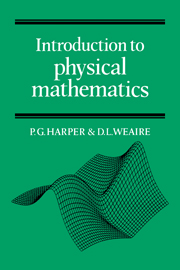Book contents
- Frontmatter
- Contents
- Preface
- Some notes on notation
- 1 Introduction
- 2 Errors
- 3 Cartesian coordinates
- 4 Vectors
- 5 The scalar product
- 6 The vector product and rotation
- 7 Matrices in physics
- 8 The transformation of matrices
- 9 The matrix eigenvalue equation
- 10 Exponential and logarithm functions
- 11 Sine and cosine functions
- 12 Graph plotting and curve sketching
- 13 Differentiation
- 14 Approximations
- 15 Power series and Taylor's expansion
- 16 Partial differentiation
- 17 Integration
- 18 The differential equation
- 19 Solving first-order differential equations
- 20 Second-order differential equations
- 21 Solving second-order differential equations
- 22 The complex exponential
- 23 The circuit equation
- 24 Harmonics and Fourier series
- 25 The diffusion equation
- 26 Waves
- 27 The rate of change of a vector
- 28 The scalar field and gradient operator
- 29 The vector field
- 30 Line integration
- 31 The potential field
- 32 Surface and volume integration
- 33 Flux and divergence
- 34 Circulation and the curl
- 35 Conclusion
- 36 Miscellaneous exercises
- Index
5 - The scalar product
Published online by Cambridge University Press: 20 October 2009
- Frontmatter
- Contents
- Preface
- Some notes on notation
- 1 Introduction
- 2 Errors
- 3 Cartesian coordinates
- 4 Vectors
- 5 The scalar product
- 6 The vector product and rotation
- 7 Matrices in physics
- 8 The transformation of matrices
- 9 The matrix eigenvalue equation
- 10 Exponential and logarithm functions
- 11 Sine and cosine functions
- 12 Graph plotting and curve sketching
- 13 Differentiation
- 14 Approximations
- 15 Power series and Taylor's expansion
- 16 Partial differentiation
- 17 Integration
- 18 The differential equation
- 19 Solving first-order differential equations
- 20 Second-order differential equations
- 21 Solving second-order differential equations
- 22 The complex exponential
- 23 The circuit equation
- 24 Harmonics and Fourier series
- 25 The diffusion equation
- 26 Waves
- 27 The rate of change of a vector
- 28 The scalar field and gradient operator
- 29 The vector field
- 30 Line integration
- 31 The potential field
- 32 Surface and volume integration
- 33 Flux and divergence
- 34 Circulation and the curl
- 35 Conclusion
- 36 Miscellaneous exercises
- Index
Summary
In mechanical drawings the orientation of the design is chosen purely for convenience. So far as the builder is concerned, it is only the relative orientation of the elements of the design that matters. Indeed, some details may be more clearly understood if the print is turned through 90°, or even read upside down.
Mathematical description of the geometrical aspect of physical phenomena is rather like this. The vector notation which uses a single symbol is handy, precisely for the reason that it is independent of reference directions. Of course at some stage in a practical calculation it usually becomes necessary to specify actual components of velocity, force etc., and these will depend upon the choice of axes. Even here, however, some geometrical features are the same whatever axes are used. Thus the distance between two points and the angle between two directions are unaffected by rotations or shifts of axes. Such fixed quantities are called invariants. Another important example of an invariant is the scalar product of two vectors.
In the i,j,k notation of chapter 4, a given vector (displacement, velocity, force, etc.) can be written a = axi + ayj + azk. The coefficients ax, ay, az, depend upon the axes chosen, and are referred to as the components of a, resolved along the directions i,j,k. Indeed the vector a may be represented by (ax,ay,az). For a position vector, this is just the Cartesian system introduced in chapter 3.
- Type
- Chapter
- Information
- Introduction to Physical Mathematics , pp. 29 - 34Publisher: Cambridge University PressPrint publication year: 1985

